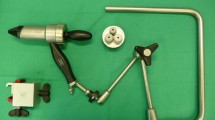Abstract
Background
Animal studies have supported natural orifice transluminal endoscopic surgery (NOTES) retroperitoneal access. NOTES also may offer unique retroperitoneal access in humans.
Objectives
This study was designed to assess the feasibility of endoscopic transgastric and transrectal retroperitoneal access in a cadaver model using prone and supine positioning, and to compare NOTES retroperitoneal examination with endoscopic ultrasound.
Methods
Using a multidisciplinary team, this institutional review board-approved study evaluated transgastric and transrectal retroperitoneal examination in six cadavers (3 male, 3 female; body mass index range, 25–37 kg/m2). Endoscopic ultrasound retroperitoneal examination preceded NOTES access. Transgastric Access: Using a prototype dual channel endoscope, a needle knife gastrotomy was created on the preantral posterior gastric wall. Retroperitoneal examination specifically targeted the pancreas and surrounding structures with the cadaver supine and prone. Transrectal Access: Using the same endoscope, a posterior needle knife rectotomy distal to the upper valve of Houston provided extraluminal access. Retroperitoneal examination proceeded with the cadaver prone and supine. Open dissection followed procedure completion.
Results
Access into the retroperitoneum succeeded at all sites. Significant challenges locating identifiable landmarks were faced—mostly transrectal and improved transgastric prone. All cadavers, despite body mass index or sex, had significant retroperitoneal adipose tissue limiting the endoscopic view.
Conclusions
Although porcine studies have highlighted successful NOTES retroperitoneal procedures, the abundant human retroperitoneal adipose tissue challenged the translation of porcine research to humans. Additionally, although access to the retroperitoneal space and dissection within this space were accomplished easily, the appearance of cadaveric tissue and lack of blood flow made confident landmark identification impossible. Further study should continue in this area and focus on confident landmark identification for directed dissection. In a cadaveric model, this would best be improved by pre-NOTES anatomic marking or active perfusion of vasculature along with consideration of direct entry into the retroperitoneum from a targeted intraperitoneal site in clinical patients.


Similar content being viewed by others
References
Perretta S, Allemann P, Asakuma M, Dallemagne B, Marescaux J (2009) Adrenalectomy using natural orifice transluminal endoscopic surgery (NOTES): a transvaginal retroperitoneal approach. Surg Endosc 23:1390
Allemann P, Perretta S, Marescaux J (2009) Surgical access to the adrenal gland: the quest for a “no visible scar” approach. Surg Oncol 18:131–137
Zacharopoulou C, Nassif J, Allemann P, Dallemagne B, Perretta S, Marescaux J, Wattiez A (2009) Exploration of the retroperitoneum using the transvaginal natural orifice transluminal endoscopic surgery technique. J Minim Invasive Gynecol 16:198–203
Escourrou J, Shehab H, Buscail L, Bournet B, Andrau P, Moreau J, Fourtanier G (2008) Peroral transgastric/transduodenal necrosectomy: success in the treatment of infected pancreatic necrosis. Ann Surg 248:1074–1080
Baron TH, Thaggard WG, Morgan DE, Stanley RJ (1996) Endoscopic therapy for organized pancreatic necrosis. Gastroenterology 111:755–764
Seewald S, Groth S, Omar S, Imazu H, Seitz U, de Weerth A, Soetikno R, Zhong Y, Sriram PV, Ponnudurai R, Sikka S, Thonke F, Soehendra N (2005) Aggressive endoscopic therapy for pancreatic necrosis and pancreatic abscess: a new safe and effective treatment algorithm. Gastrointest Endosc 62:92–100
Charnley RM, Lochan R, Gray H, O’Sullivan CB, Scott J, Oppong KE (2006) Endoscopic necrosectomy as primary therapy in the management of infected pancreatic necrosis. Endoscopy 38:925–928
Voermans RP, Veldkamp MC, Rauws EA, Bruno MJ, Fockens P (2007) Endoscopic transmural debridement of symptomatic organized pancreatic necrosis (with videos). Gastrointest Endosc 66:909–916
Papachristou G, Takahashi N, Chahal P, Sarr MG, Baron TH (2007) Peroral endoscopic drainage/debridement of walled-off pancreatic necrosis. Ann Surg 245:943–951
Ryou M, Fong DG, Pai RD, Tavakkolizadeh A, Rattner DW, Thompson CC (2007) Dual-port distal pancreatectomy using a prototype endoscope and endoscopic stapler: a natural orifice transluminal endoscopic surgery (NOTES) survival study in a porcine model. Endoscopy 39:881–887
Dunkin BJ, Wilson E, Yu S, Sherman V, Herrera P, Silverman E (2008) The first human abdominal surgery in prone position: an example of how NOTES can be used to perform unique procedures. SAGES Video Abstract 2008, Final Program 137
Acknowledgment
This work was supported by 2008 Natural Orifice Surgery Consortium for Assessment and Research (NOSCAR™) STORZ Research Award.
Disclosures
Drs. Moran, Bingener, Murad, and Levy have no conflicts of interest or financial ties to disclose. Dr. Gostout and the Developmental Endoscopy Unit receive a yearly grant from Olympus America and Olympus Tokyo. Dr. Gostout is an advisor to Apollo Endosurgery; both he and the Mayo Foundation maintain an equity position in Apollo Endosurgery, Inc.
Author information
Authors and Affiliations
Corresponding author
Rights and permissions
About this article
Cite this article
Moran, E.A., Bingener, J., Murad, F. et al. The challenges with NOTES retroperitoneal access in humans. Surg Endosc 25, 1096–1100 (2011). https://doi.org/10.1007/s00464-010-1323-4
Received:
Accepted:
Published:
Issue Date:
DOI: https://doi.org/10.1007/s00464-010-1323-4




